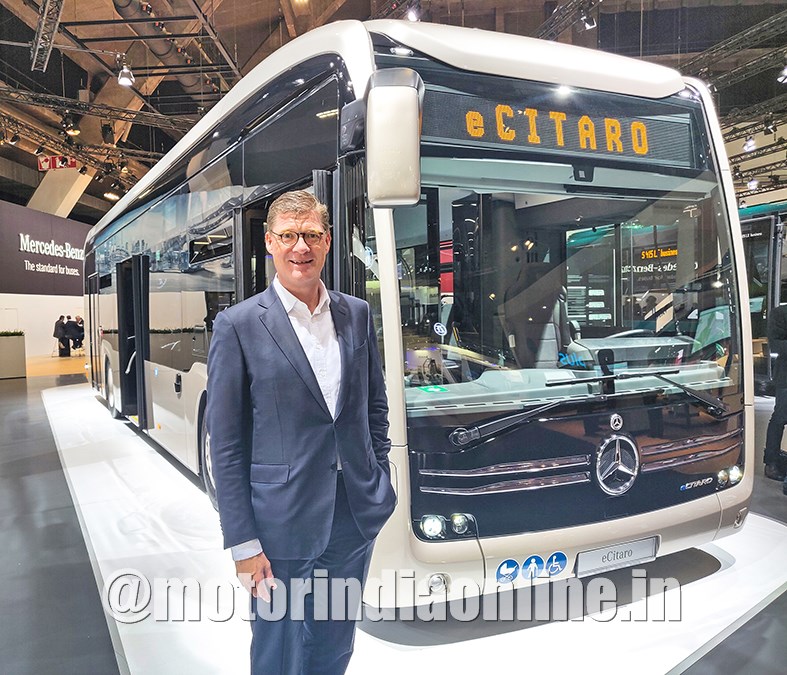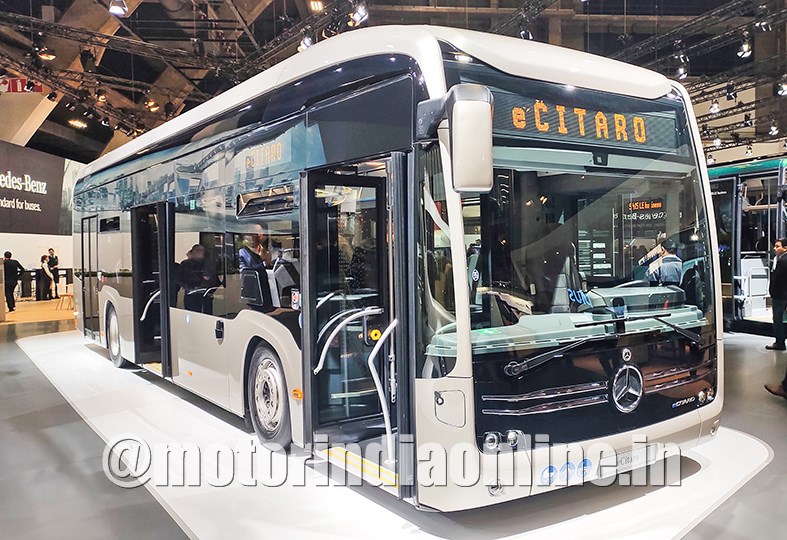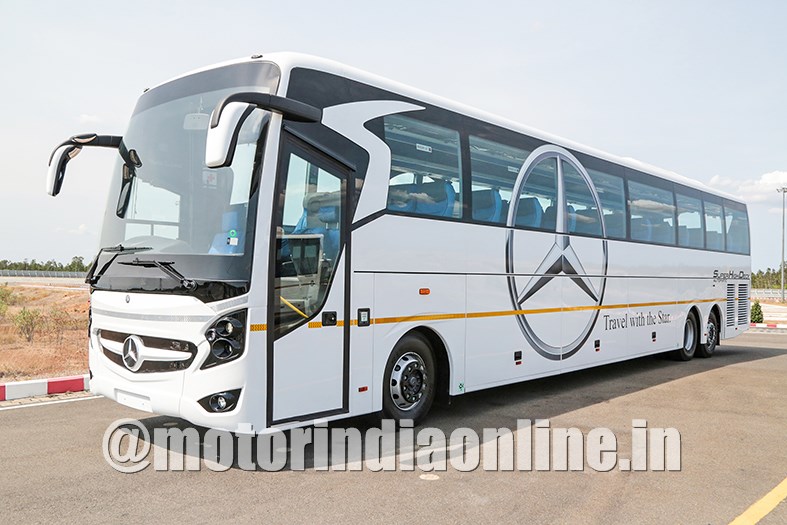“There is no one size that fits all. The world is not alike all over, so we have to adapt to the local necessities of the markets and regions we work with. From my point of view, as a bus maker, it is always about packaging – with right products, solutions, and services – and listening to our customers”, says Till Oberwörder, Head of Daimler Buses, in a brief candid interaction with Dhiyanesh Ravichandran.

Edited excerpts:
Europe is home to Daimler Buses. How significant and foretelling is the region to your company in terms of its evolution in buses over the years?
The world is constantly changing. So are the bus industry. In Europe, the public is very much in favour of public transport, which is very helpful for the segment overall. More and more people are moving towards cities and living in one. The focus is on sustainable city life. How can electrified vehicles, and buses, in particular, can contribute towards that? Thus, the city needs are driving new technologies in our industry very much in Europe.
On the other side of the spectrum are the coaches, where the evolution of efficient Euro 6 engine technologies dominating the scene. This segment is also more about individualisation of products, wherein ‘there is no such thing as second identical coach’! Buses are individualised to suit the custom needs of our customers. There is a huge scope for innovation and growth in this space as well.
Electric mobility is the talk of the town and is predominantly taking over the bus industry. Where is Daimler placed in this development, what is the progress so far and what more can we expect?
When we came up with eCitaro in 2018, we always wanted to have an electrified product that is coming out of the normal production line, and not a ‘project’. It is built like every other Citaro models powered by either diesel, gas, or hybrid powertrains on the same production line. I think that’s important because, as a bus maker, we can address the diverse demands of our end customers identically.
The other aspect is that it became quite clear to us that a mere e-bus product is not just enough. As there is a change in technology that goes behind the bus, there also comes a slew changes in the way it is operated as well. In consequence, we need to accompany our customers in every way possible, including that of e-mobility consultancy, delving on various parameters like charging technologies and infrastructure, management of depots, and even down to the point on how these vehicles are to be serviced and maintained.
Considering the buzz surrounding the shift in the bus industry towards electric mobility, which are the markets, according to you, that are actually ready for such a critical transition?
Right now, I would say that Europe is the driving force behind the transition from conventional to electrified buses. However, on the other hand, some countries in the Latin American region are also driving in that direction. Even in India, discussions are underway to electrify public transport, even some products are available. That way, we cannot just deselect any region in the e-bus debate. Different countries may have different goals on emission reductions and strategies to clean public transport, but electric buses are an essential part of the discussion in every market. We are keeping our fingers crossed as well!
With growing popularity of rapid transit rail systems and other fashionable modes in cities across the globe, how relevant are buses today in this regard?
Perhaps this is more of a generic statement, I strongly believe it has never either bus or rail. These are something that goes together always – ‘inter-modality’ is what we are talking about in public transportation these days. That’s simply because the modes or the mix depends on the prerequisites of a particular city, for example.
Daimler Buses have a lot of experience when it comes to public transport, may it be ‘MaaS’ (Mobility-as-a-Service) or ‘BRT’ (Bus Rapid Transit) we are talking about. In the latter, for instance, the benefit is that one can quickly install a dedicated bus line and ply high-capacity articulated buses that can transport masses with a 20-second commute duration from one station to another. In terms of installation and investment point of view, the BRT quicker and less expensive comparing to rail-based rapid transit systems. That way, buses are still an integrated part of public transportation systems. Today, some 180 BRT systems are operating worldwide, and we have a notable share in that segment.
The Asian region is fast catching up with Europe in terms of market potential. How is Daimler Buses performing in this region? How significant is the Indian market in this respect?
Asian markets are yet another growth driver. Take, for instance, we have a production facility in India, wherein the 9T and 16T bus platforms are the prime focus for our company, and we are fast-growing. It is just one major indication that we are going to stay in the Indian region and build up our business there. That’s not all, we are also looking at the possibility of establishing India as an export hub. We consider India rightly placed in terms of covering markets – not just the one in its vicinity but also others like that of the Middle East or African countries – that demand similar quality products. Thus, apart from the domestic stream, we are also looking at regional and international potentials from markets in Asia.
Ultimately, much of this depends on what customers in each market want. An interesting point about Asia, in general, different markets call for different product concepts, may it be fully-built concepts on the lines of Europe or chassis-body product concepts as the case in India. Daimler’s charm is that the group has different brands under its fold, offering us flexibility in addressing the diverse needs of markets with a wide range of product and platform specifications.
The 2020s is here. How do you see the bus industry panning out in this new decade? What sort of technological evolution and business models one can expect in the next ten years?
I do see the future a positive and bright future for buses out of a couple of reasons. One, with more and more people moving into cities, we have to provide robust public transportation. Buses are highly sustainable, economical and eco-friendly modes, and can contribute tremendously towards a sustainable transport system for our cities. Considering its strong position in this aspect, the growth potentials for the bus industry as a whole is also very high.
Two, the world is not alike all over. As we see, many countries around the globe are now stepping into new emission grades, transitioning from Euro 3 or 4 equivalent to Euro 6 standards. That’s great for the bus industry again, while also contributing to the development of sustainable buses and CO2 reduction.
Lastly, business models will continue to be different by regions. Although certain basic logics of offering products, services, and packaging are alike around the world, the differences are in the details. Not just market-wise, take for instance the technology of e-mobility. We have to have a different approach to utilise data and connected technologies to offer our services. Everything from basic operational characteristics of the bus to its charging and performance dynamics follows complex algorithms, and end-users are to be engaged in these technologies to get the best out of the product. In a nutshell, there can be no one size that fits all. Depending on the market or region, we have to adapt to the local necessities of the end customers to offer the right packages and solutions they appreciate.

